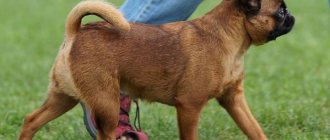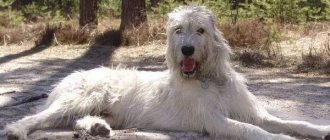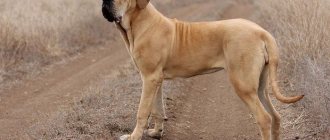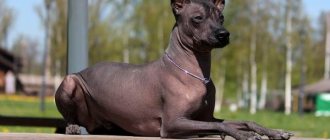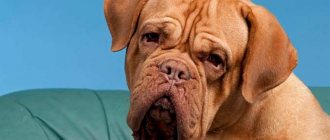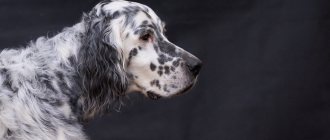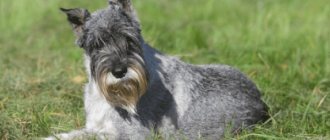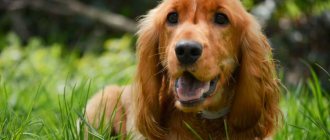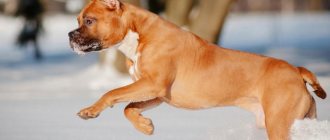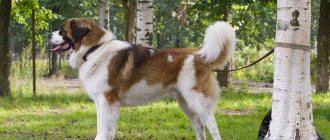Description of the Petit Brabançon breed
Popularity 42nd among 263 dog breeds
Lifespan:
12-15 years
Breed group:
Decorative
Height:
16-26 cm
Country of origin:
Belgium
Average price:
20-40 thousand rubles
Weight:
3-6 kg
Latest articles Cat health
Rabies vaccination for cats: choice of vaccine, necessity, schedule 01/22/2022 15 0 0
Selection and adaptation
TOP 20 best cat breeds for families with children 01/22/2022 27 0 0
Characteristic diseases
The average life expectancy of representatives of the breed is from 8 to 14 years. In general, Petit Brabançons have good health, especially if they receive quality care. But there are a number of ailments that are often found in griffins due to their body structure and genetic predispositions:
- Cataract (clouding of the lens). The disease most often develops with age, causing vision to deteriorate significantly. If you notice changes in orientation and a decrease in your pet’s attentiveness, and even more so, visual changes in the eye, you should immediately go to the doctor. Without timely drug therapy or surgery, the animal will lose its vision.
- Prolapse of the eyeball (proptosis). A short skull is a factor that increases the likelihood of the eye coming out of the bony orbit. If such changes are detected, it is important to take the dog to the veterinarian - the situation can be corrected by surgery, during which the eye will be straightened and fixed with sutures.
- Bifurcation of the dentition. Due to the small size of the jaw, Brabant griffins often do not lose their milk teeth when their permanent teeth begin to grow, which is why the latter begin to emerge in the second row. The owner must monitor the change of teeth and, if a problem is detected, go to the hospital so that the doctor can remove the interfering baby tooth.
- Respiratory tract diseases. The brachycephalic shape of the skull, accompanied by shortening of the airways, increases the risk of developing inflammatory diseases (rhinitis, bronchitis, etc.). If your dog has increased mucus from the nose, sneezing or coughing, or swollen eyes, then you should go to a veterinary clinic, where they will make a specific diagnosis and prescribe medication.
Key facts
The Petit Brabançon, or Brabant Griffon, is a curious and sociable dog that is not characterized by groundless aggression. The pet is not vindictive, loves children, and since its intelligence corresponds to the level of development of a three-year-old child, this dog will be an excellent playmate. The characteristics of the Brussels Griffon breed also say that he is not jealous and accepts other animals in the family well.
The Brabant Griffon is very attached to the family and, in particular, to its owner, whose mood is easily read. He is always ready to console if the owner is upset and rejoices with him. This breed does not tolerate being transferred to another family or even being left in foster care very well. If possible, take your dog with you on your trip.
The description of the Petit Brabançon breed says that the dogs are easy to care for and have good health. These dogs love to be the center of attention and are great companions. The life expectancy of the Petit Brabançon is long and can reach up to 15 years.
Hygiene
Regular care allows you to maintain the health of your Brabant Griffon and avoid the development of diseases:
- Dogs should be combed regularly with a comb and a furminator should be used once a week.
- Bath once every couple of months; in case of severe contamination, the number of baths can be increased. When washing, use a special shampoo for short-haired dogs.
- Eyes should be wiped or washed daily.
- Brush your teeth with a small brush and toothpaste for dogs.
- Clean your ears of wax every 2-3 weeks.
- After a walk, wipe your paws with a damp cloth or towel.
History of the origin of Petit Brabançon
The history of the breed dates back to Europe in the 15th century. Small dogs were called “stable griffons” and were engaged in catching mice and rats in stables. Thanks to their flexible, cheerful and non-conflict disposition, griffons captivated the nobility, including the royal circle, and quickly moved to the silk cushions of palaces and carriages. In particular, members of the Belgian royal family were great admirers of griffins.
Petit Brabançons were first presented at the exhibition in 1880, where they received recognition from the audience and excellent marks from the judges. After this, the breed quickly became popular, but, unfortunately, the quality of the livestock was sacrificed to quantity.
It is unknown what would have happened to the breed if Maria Henriette, the Queen of Belgium, had not been its great admirer. She put a lot of effort into purebred dogs, and they were successful. By crossing breeds, different types of wool were obtained - hard in Griffons and smooth in Petit Brabançon. The muzzle of these dogs is inherited from the Affenpinscher, and the Cavalier King Charles Spaniels took part in the coloring.
In the 20th century, the Belgian government allowed foreigners to purchase puppies and export them outside the country. During the Second World War, Petit Brabançons, like many breeds, were exterminated, as a result of which the population greatly decreased and became endangered. Thanks to the fact that individuals were preserved in England and the USA, breeders managed to restore the breed, slightly changing the exterior. Corrections and additions were made to the standard twice - in 1963 and in 2003. Now the appearance of Petit Brabançons is so familiar that it is difficult to imagine that they once looked different.
Despite the proximity of Europe and Russia, the first Brabant Griffons came to us from the USA only in 1993. The first Petit Brabançon kennel was founded in St. Petersburg and was named “Nevsky Hobbit”, and a little later the breed found its way to Moscow. In 1999, the number of Russian Petit Brabançons was 85 dogs.
History of the breed
The birthplace of Petit Brabançon is Belgium.
The appearance of the breed dates back to the nineteenth century. This species originated as a result of crossing the German Affenpinscher and the Belgian yard dog.
In those distant times, there was a fight against rats, which were the main carriers of infections, in particular the plague.
Cats could not cope with the hordes of rodents that filled not only villages, but also cities. Therefore, breeders paid special attention to breeding dogs capable of hunting rodents.
The Little Brabançon became just such a dog; he was known as the ideal rat catcher. At first, his abilities were used in the homes of middle-income people, in ports, and in warehouses.
Over time, thanks to breeding work, the appearance of the smooth-haired griffon has changed somewhat. The breeding work involved varieties of Griffons, Pugs and King Charles Spaniels.
Changes have taken place for the better. Miniature dogs with a “human” expression on their faces were noticed by representatives of high society and royalty.
Brabant griffons began to guard royal motorcades; they were considered a fashionable addition to almost every society lady, accompanying housewives on trips and participating in meetings held in women's boudoirs.
In any place where a griffon appeared, the rodents were exterminated in a matter of days. This species was rightly proclaimed in 1880 to be the national breed of the royal family of Belgium. In the same year, pti-brabanson took part in the exhibition for the first time.
Today, Petit Brabançon still loves to hunt rats and mice, but it is valued not for these qualities, but for its decorativeness, friendliness and cheerful disposition. The breed is popular all over the world.
Appearance of Petit Brabançon
General impression
Petit Brabançons are small “pocket” dogs with a fairly strong bone structure and strong build for their size. In the photo, the Petit Brabançon is eccentric, but at the same time it is a very harmonious dog. The standard for Petit Brabançons is the same, and “mini” and “standard” individuals are just a trick of unscrupulous breeders who sell purebred crosses or simply want to increase the price.
Head
The head is harmonious in relation to the body, despite its rather large size. The large forehead turns into a clear stop. The muzzle is of very moderate length, which is no more than 1.5 cm, ending with an upturned nose not lower than the eyes.
The lips are tightly closed, the lower jaw is wider than the upper, quite rounded. Bite – snack. The cutters must be complete.
The eyes are not protruding, but set far apart from each other, round and large. Eye color is dark brown, good if the whites are not visible.
The ears are small, set wide and high. If the ears are cropped, then they stand, and undocked ears are semi-dropping. The disadvantage is that the ears are too large. The nose is wide and always black.
Neck
The neck is of medium length, smoothly blending into the withers and shoulders.
Torso
A body that fits neatly into a square, with a short straight back, a fairly short loin and a slightly sloping croup that is in no way narrow. The chest is deep and wide, visually protruding slightly forward. The bottom line is taut.
Forelegs
The forelimbs with strong bones are set wide and parallel, and the elbows are tucked. The paws are round, evenly set, with compressed but not fused toes. The pads are soft, preferably dark in color. The claws are preferably black.
Hind limbs
The hind limbs are also parallel, with developed muscles and good bones. The angulations are well defined, the hocks are noticeably dropped. There should be no dewclaws on the paws.
Tail
The tail is most often docked by one third, set high and carried upward. If the tail is not docked, then the tip is directed towards the back, but is not curled or thrown over the back.
Movements
The movements are powerful and parallel, with a confident push. Ambling is a fault, as is throwing up the forelimbs.
Wool
The coat is very short, no longer than 2 cm in the most combed places. It is dense and shiny, moderately tough. Unlike griffons, Brabançons have a smooth muzzle without a brush.
Color
Petit Brabançon colors can be black, fawn, or mixed. The black color comes with red, red or fawn patches. One mandatory requirement remains - a dark mask on the face for any color.
Dimensions
The height of the Petit Brabançon at the withers is allowed from 16 to 26 cm, and the weight of the Petit Brabançon is determined in the range from 3.5 to 6 kg. Dimorphism is moderately pronounced, females are slightly shorter and lighter than males. Males should not suffer from cryptorchidism; both testicles are in the scrotum. In general, the size of the Petit Brabançon should not be too large.
Breed standard
The Petit Brabançon is part of the group of small Belgian dogs. It differs from its fellows by having short, pug-like hair.
The body type of a smooth-haired griffon is square, bony.
The weight of adults is 4-5 kg. , height 20-24 cm .
A relatively large head rests on a not too long neck. The forehead is convex.
Small ears are semi-erect (natural) or erect triangular (cropped).
The eyes are large, but not bulging. Round, brown.
The muzzle is short. The nose is snub. The nose is black, large, with well-open nostrils.
Type of bite – undershot. The jaws are wide and strong. The lower one is curved upward and protrudes beyond the upper one. The lips are adjacent, the upper one covers the lower one.
The loin is short and has a slight convexity. The back is flat and wide. The chest is relatively voluminous.
The hemline is slightly tucked. The tail is directed upward. If we dock, then by 2/3 of the original length.
The legs are parallel, strong, even, with well-developed muscles. The paws are round and small.
Based on their coat type, pti-Brabansons are divided into smooth-haired and wire-haired. They differ from each other solely in their coat.
The coat is short (no more than 2 cm in length), dense, shiny.
Brabançon color: black, black and tan, red.
Character of Petit Brabançon
Petit Brabançons are very sociable and become attached to their owner and family. Their muzzle has pronounced facial expressions, the dog’s mood and emotions are easy to read, they are almost human.
Petit Brabançons are excellent companions for children; they are smart, playful, unforgiving and non-aggressive. They get along well with other animals, birds and rodents.
The Brabant Griffon loves to be the center of attention, he loves guests and company. People, in turn, are also usually fascinated by the canine gentleman. This little dog is full of self-esteem, has a developed mind and courage.
Representatives of this breed have a very difficult time being separated from their owners, so it is better to take your Brabançon with you on trips and travels. If this is not possible, it is better not to take the Brabant for foster care, but to invite home a person you know well, with whom it will be easier for the dog to survive the period without owners.
Petit Brabançons prefer to sleep with their owner, preferably under the same blanket. This breed is not gibberish and will not annoy neighbors with non-stop barking. An undoubted advantage of the Petit Brabançon's character is the ability to adapt to the lifestyle and mood of the owner.
The Brabant Griffon happily walks outside, but you can train him to go to the toilet at home in a litter tray or on a diaper. In winter, these kids get cold outside, so it’s better to warm them up by wearing overalls.
Brabançons live exclusively at home, and probably no one would think of keeping these little ones in an enclosure. They feel good both in an apartment and in a country house.
Who is the breed suitable for? Thanks to its small size and wonderful character, the Petit Brabançon can be recommended to almost everyone, with the exception of people whose work involves frequent or long-term business trips.
Kinds
This breed is classified as shorthaired. The dog's fur barely reaches 2 cm. It is shiny and delicate. Since the genes of a large number of breeds were used to create the Petit Brabançon, there are many variations in its color. The most popular options:
- Deer.
- Mixed (black with reddish spots).
- Pure black.
- Ginger.
Petit Brabançon puppies are born with coarse black fur. They can change color as they grow older or leave it unchanged. According to the standard, if there are tan marks on the body of an animal, then the color of its coat should be contrasting and very rich. Such individuals may have spots on the hind and forelimbs.
Education and training
Despite its size, the Petit Brabançon needs training. The well-developed qualities of the breed will turn a well-mannered Brabant into a wonderful companion.
Raising and training the Petit Brabançon is easy due to its high intelligence and quick wit. He learns clear commands well. It is vitally important to accustom the puppy to the commands “Come”, “Fu”, “Near”. Mastering the discipline requires some amount of repetition of the exercises. Pleasant commands like “Walk” and “Eat” are learned easily and quickly and do not require any special training.
Brabançons are trained using the carrot and stick method. The carrot is delicacy and praise, and the stick is the dissatisfied tone and look of the owner. The “carrot” should be given out only after the exercise has been performed correctly. Miniature dogs should not be physically punished.
Representatives of this breed easily pass the mini-OKD, which differs from the usual one in the distance between the pet and the owner. Brabant Griffons can also participate in sports competitions, in particular agility.
A well-mannered and trained pet is a wonderful friend and part of the family.
Advantages and disadvantages
Knowing the advantages and disadvantages of the breed allows future owners to assess in advance their strength in raising such a pet as the Petit Brabançon.
The main advantages of animals include:
- kindness;
- sense of humor;
- mind;
- savvy;
- learning ability;
- lack of aggression;
- small sizes.
Among the disadvantages, they note that dogs pick up all sorts of garbage from the ground and require training from an early age. They are prone to eye and skin diseases.
Note! Petit Brabançon is not suitable for people who travel frequently. Dogs do not tolerate separation well.
Health and disease of Petit Brabançon
Possible diseases
Petit Brabançon enjoys good health. A healthy dog lives and pleases its owners for a long time. However, there are diseases that representatives of this breed are prone to:
- Retinal atrophy, which impairs vision and can lead to complete blindness.
- Proptosis, in other words, prolapse of the eyeball.
- Distichiasis is an abnormal growth of eyelashes, which can cause blepharospasm, conjunctivitis, and in severe cases, deep ulcerative lesions of the eyeball.
- Turn of the century.
- Diseases of the oral cavity and teeth - cleft palate, simultaneous growth of milk and permanent teeth.
- Tendency to infectious and colds.
- Skin diseases, although Brabançons are not prone to allergies.
- Dislocation of the kneecap.
- Obesity.
Puppies and adult dogs must receive vaccinations on time, before which dogs are wormed two weeks before. An unvaccinated puppy should avoid contact with other dogs. Petit Brabançons need good care, proper feeding, and disease prevention.
Reproductive health
Petit Brabançons can be bred with Brussels and Belgian Griffons, but the genetics of color inheritance must be taken into account. Therefore, if you are not an amateur owner, it is better to breed Petit Brabançons with Petit Brabançons so that the color of the puppies is not affected.
Brussels Griffon bitches are bred no earlier than the second or third heat. Before breeding, the bitch must be vaccinated and treated against parasites, and must also attend at least one exhibition and receive a rating of at least “very good.” choir." You should not breed an overweight bitch - pregnancy and childbirth are very difficult for her. It is better to wait with the mating and keep the girl on a diet for a while. Animals must be bred with documents and without defects, otherwise sterilization will be the best solution.
Mating is carried out in the middle of estrus, on days 9-14. Within two days, a second – control – mating is usually carried out.
If pregnancy has occurred, then there are from 56 to 72 days left before the birth of the offspring. Pregnancy can be confirmed after 4-5 weeks by ultrasound. In the second half of pregnancy, the bitch requires increased nutrition. The dog should exercise a lot so as not to gain excess weight, which could interfere with childbirth.
There can be up to 4-5 puppies in one litter. Childbirth in this breed often involves complications, so it is better to enlist the help of a veterinarian or an experienced breeder who will be present at the birth. The life of the puppies and the bitch herself depends on timely assistance.
Lifespan and reproduction
Griffons are long-lived. The average lifespan of a pet is from 12 to 15 years. Exactly how long a pet will live depends on the quality of food and care.
Brabant Griffons are long-lived. Their lifespan reaches 15 years
Animal breeding is carried out by specialists in nurseries. For breeding show dogs, representatives of the breed without disqualifying defects are used. This allows you to get premium puppies and increase their final cost.
Mating is carried out after 2-3 heats of the female. Estrus continues for 20-22 days. The best time comes from 9 days. If the puppies are not expected to participate in exhibitions, then mating with other griffons is possible.
Features of feeding and diet
The little native of Brabant is picky when it comes to food, and it is almost impossible to feed him something he doesn’t want to eat. Your pet needs to purchase a bowl on a stand or adjustable bracket so that his posture does not deteriorate. You need to feed your dog at the same time, after a walk, and do not give it more food than normal, remembering its tendency to obesity.
Puppies up to 6 months of age continue to have 4-5 meals a day, and by 10-12 months of age, 2 feedings remain, just like an adult dog.
It seems more rational to feed the dog with ready-made industrial food. They do not need to be cooked, it is easy to maintain calorie standards, and no additional intake of vitamin complexes or dietary supplements is required. The food must be at least premium or holistic.
Carefully read the composition of the feed - the meat component should come first, and not in the form of meat and bone meal, but in the form of meat and offal. The food should be suitable for small breeds, that is, it should consist of small granules.
The natural diet of a Petit Brabançon should include lean meats as a base, cereals and cereals, vegetables, some fruits, eggs, fermented milk products, and sometimes boneless sea fish fillets, shrimp, and squid can be given.
You cannot feed your pet:
- fatty meat and lard;
- river or bony fish;
- fried, spicy, salty;
- sweets and flour;
- bones, especially tubular ones;
- legumes, potatoes.
As a treat, you can please your pet with low-fat varieties of cheese, special treats that are sold in pet stores, boiled liver, heart or tripe. Treats should not be substituted for feeding.
How to choose a puppy
When choosing a puppy, you need to pay attention to both the appearance of the pet and its behavior. A healthy pet should be playful and curious, and not be afraid to make contact with people. He has no secretions on his mucous membranes, his coat is shiny, and the color is rich. There are no jaw defects, the teeth are white without plaque.
It is best to buy a puppy at the age of 3 months. By that time, they have already grown up enough and are showing independence. It is important to find out whether the babies have been vaccinated and look at the veterinary passport.
Pros and cons of the breed
| + | – |
| Gets along well with children | There is moderate seasonal shedding |
| Gets along with other pets | No security qualities |
| Does not require much physical activity | No pronounced guard qualities |
| Easily trainable | |
| Easy to care for | |
| Suitable for apartment living | |
| Suitable for agility |
Care and maintenance
Keeping and caring for the Petit Brabançon is simple. If the hair bothers you, one or two brushes per week or a little more often during shedding is enough. Washing the dog should be infrequent, when dirty or before shows. You need to be especially careful when washing your dog in winter. The wet Brabançon should be taken to the room in a towel and dried with a hairdryer. You should not leave drying to chance, let an undried pet run through drafts or walk on the street, remembering their tendency to catch colds. This breed does not require cutting or grooming.
The ears are cleaned once a week with a cotton pad and hydrogen peroxide. If you feel an unpleasant odor, too much wax, something is gurgling in the ear, or the dog is shaking its head, then contact the veterinary clinic - these could be symptoms of a variety of diseases.
The eyes are wiped in the morning to remove exudate. Pay close attention to the eyes: you need to see a doctor if there is too much exudate or it is purulent, there is increased tearing, the dog blinks frequently or the eye seems to be squinting.
Nails are trimmed once a month; for this you need to purchase a nail clipper. Petit Brabançons do not really like this procedure, but any owner can handle such a baby.
Although Brabant Griffons live at home and can go to the toilet in a litter box, communication with their relatives is very important for them, therefore, you need to walk your Petit Brabançon at least once a day. A walking area with the same small breeds is well suited. In addition, an active walk keeps the dog in good physical shape and develops its mind.
Mating
Dogs can be bred only after full puberty. Females will begin estrus by 8-10 months , but they will be able to bear healthy puppies only for the 2nd year of life , when the 3rd estrus . The owner is obliged to monitor the pet’s cycles, marking the beginning and end. Usually, girls flow 2 times a year , the maximum gap is 8-9 months .
A few days before the start of a new cycle, the owner needs to register with a club or nursery if he needs to pick a pair. There , experts will choose a male that complements the girl according to external criteria. The owners will sign papers that will later help in processing paperwork for the puppies.
When choosing a date for mating, you need to pay attention to the days of ovulation. 13-15 days are considered favorable . You can understand that the female is ready by several signs: light discharge, playful behavior, loose soft loop.
On the appointed day, the dogs are brought together and given time to get to know each other. You can seek the help of a professional who will help your pets understand the process. When the male dog mounts, the owners will have to help their pets stand. It is important to keep the animals in the castle for 5-10 minutes .
Repeat mating after 48 hours . You can track the progress of pregnancy at a veterinary clinic, but you can check the presence of embryos only after 2-3 weeks using an ultrasound. Tests do not always work, and probing in the early stages does not give results.
Read a detailed article on the topic: “Everything you need to know about breeding dogs: appropriate age, what to do if it doesn’t work out, rules and tips.”
Tips for choosing a puppy
You should not buy a puppy without a pedigree. Such Petit Brabançon puppies are cheaper, but they are often resold. These poor creatures are kept in poor conditions, they are taken away from their mother a month, or even earlier, often these puppies are sick. By saving on the price of a dog, you can spend an amount significantly exceeding its cost on treatment, and in the best case, you will become the owner of a sickly low-breed dog without documents, and in the worst case, the treatment will not help, and the puppy will die from an infection. In such cases, there is no one to file claims with; the puppy seller has received his money and washed his hands of it.
Choose trusted nurseries, where you can get full advice on the breed and puppies, view and check all documents. Puppies from a good breeder are clean, well-fed and active, have an RKF puppy card, a brand and a veterinary passport with their first vaccinations. They are already eating premium food, they have clean ears and eyes that look at you with curiosity.
It is better to buy Petit Brabançon puppies at the age of 2-3 months, when they are no longer breastfed and are completely ready to go to a new home.
The sex of the future pet is the owner’s choice, but both females and males have a wonderful character. Males are not dominant, but females are affectionate. Aggression is not typical for the breed, but you should not choose a timid puppy. It is very difficult to determine the quality of a puppy’s coat - the situation will become clearer when the baby grows up.
Nutrition
Before feeding your Petit Brabançon new food, you should first consult with the breeder, especially for puppies, and then with your veterinarian. Until the age of six months, they try to feed the little Brabançon according to the nursery’s recommendations. An older dog is switched to an appropriate diet.
It is categorically not recommended to pamper a puppy, to compose a diet from those foods that he likes, and not from what dogs should be given in puppyhood. Quite quickly, such puppies grow into domestic tyrants, demanding satisfaction with goodies.
Small breeds prefer to be fed from the table. But it is strictly not recommended to do this with giffons. It is best to feed them with special super-premium food for small breeds and avoid harmful variety of food.
As you age, you should add vegetables to your main diet - pumpkin and zucchini, as well as fruits - apples and bananas. It is not recommended to give either grapes or sweet fruits and berries. You can replace one feeding per week with lean meat, liver or heart, after all, dogs are natural predators.
Meat can be alternated with sea fish, giving it once a month, not forgetting to arrange fasting days for gluttonous pets.
